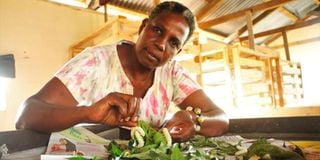Premium
Fashion designer keeps silkworms to make own fabrics

Lucy Bigham examines Eri silkworms at a production station in Wote Town, Makueni County. She makes silk fabrics from the worms.
Nestled between residential estates and mango orchards, Lucy Bigham’s castor beans plantation in Wote Town, the administrative capital of Makueni County, stands out in many ways.
The fashion designer has turned down the allure of the millions of shillings that real investors flash to farmers to surrender the farmlands in prime locations around the rapidly expanding town so that they can set up urban homes, skyscrapers and stores. Instead, she has set up the castor plantation that feeds her vibrant eri silkworm and textile enterprise.
Seeds of Gold team finds Lucy checking on her castor bean plants that sit on one acre. “Many farmers in this region dismiss castor plants as weeds as they grow on their own in the wild. But we have realised that the leaves of the plant are super food for eri silkworms whose cocoons yield expensive silk and pupa that is a source of proteins for chicken and humans,” she says, lifting the lid on the production of one of the most expensive fabrics in the world.
Trading as Tosheka Textiles, Lucy’s role in the eri silkworm enterprise is mainly managerial. Her day starts with supervising the feeding of the silkworms in their cages in a specialised breeding house at Kiatine village, some 30km away from the castor bean plantation.
During a guided tour around the eri silkworm breeding house, Lucy reveals how a slump in the production of cotton in the region tossed her into the deep end of sericulture, the cultivation of silkworms, in 2016.
Right decision
Within no time, she realised that she had made the right decision by embracing silkworm farming, a new venture that experts hail as climate smart and environmentally friendly compared to cotton as it does not require the use of agro-chemicals to undertake.
Farming the eri silkworms takes 19-21 days and starts with propagating eggs from moths. A pair of male and female moths lay at least 300 eggs. Feeding starts immediately after the eggs hatch into worms.
The worms change to pupae, which is housed in cocoons, before transitioning to butterfly. The pupae in the cocoon is covered by an outer silk shell.
“To enhance the production of silk, we roll five worms in newspaper montages and leave them for seven days. The silk shell attaches itself onto the newspaper thus becomes easy to harvest. We select only a few of the healthy pupae for propagation. We dry and roast the rest and feed to chickens. When roasted and crushed, the pupa can be used to manufacture healthy bars and blend multiple human foods as they are rich in protein,” Lucy says.

Lucy Bigham on her castor beans plantation in Wote, Makueni County.
Despite its huge promise, the silk industry in Kenya is underdeveloped. In a bid to solve the problem, the Kenya Agriculture and Livestock Research Organisation (Kalro) set up a Sericulture Research Centre in Thika Town. The institution trains farmers and they can source the worms from there for rearing.
The eri silk production should take place in well-ventilated houses built specifically for breeding the worms where high standards of sanitation are observed to avoid diseases. The institute says the most important ingredient in rearing eri silkworms is castor plants.
“Farmers interested in sericulture first need to plant enough castor to feed the worms. We are currently setting up trials on characterisation and evaluation of castor varieties to find out which ones will perform best in which areas. Farmers need this information beforehand,” says Noel Makete, the director of the Karlo Sericulture Research Centre.
Fast-maturing
Meanwhile, a growing rural farming community in Makueni County has continued intercropping castor bean plants with maize, beans and peas. The herbaceous shrub is fast-maturing and tolerant to drought. They thrive in deep well-drained loamy soils and in hot regions, which experience 500-600 millimetres of rainfall.
A spot check has shown that many farmers plant castor seeds directly in shallow holes on the seedbed. Although agronomists recommend 2m spacing from plant to plant, Lucy has gone for 3m. “We prune the shrubs regularly to enhance the production of leaves and facilitate harvesting. The spacing is wide because we anticipate the shrubs will soon become dense,” she says.
The biggest challenge facing the production of castor bean plants is attack by doves which snack on mature seeds. To overcome the challenge, Lucy has hired a farmhand to ward off the birds using an electric catapult. Harvesting of the seeds takes place as soon as they mature to avoid the attacks by birds and dispersal.
She has engaged 90 local farmers who produce silk all year round. They grow castor seeds themselves or go for its leaves along riverbanks in the region. The leaves are sliced into small pieces before they are fed to the eri silkworms.
The castor plants themselves have multiple other uses. The seeds are a major source of oil which is highly sought in the fuel, cosmetics and pharmaceutical industries. The plants are also known for repelling some pests. Lucy concentrates with the production of silk which she uses to manufacture assorted clothing products at a workshop in Wote town.
After making the fabrics, she works closely with fashion designers who make assorted hand-crafted textile products, which are sold in Nairobi and other high-end markets.
“The prices of our fabrics range from Sh1,500 to Sh5,000 a metre depending on the texture, weight, and thread combination,” she says.

Lucy Bigham with some of her silk products at Wote Town in Makueni County.
The first step in making clothes from silk cocoons is separating the pupa from the silk shell. The shell is then taken through a degumming process to produce fibre, which is converted to a yarn through spinning.
“We blend the silk yarn with cotton to make fabric. To add value on the materials, we dye them using organic dyes made from the backs of indigenous trees,” offers Lucy.
Some of the products Tosheka makes at its workshop are curtains, half-blankets, and pillow cases. The demand for clothes made of eri silk is high because of the thermal properties of the material. “Eri silk clothes can be worn when it is cool and when it is hot.”
According to Ms Makete, all the silk produced locally is not enough to meet the demand of the domestic cottage industry.
“Eri silkworm rearing has a promising future,” she says while advising farmers to sell raw silk rather than the cocoons to get value for their ventures.





